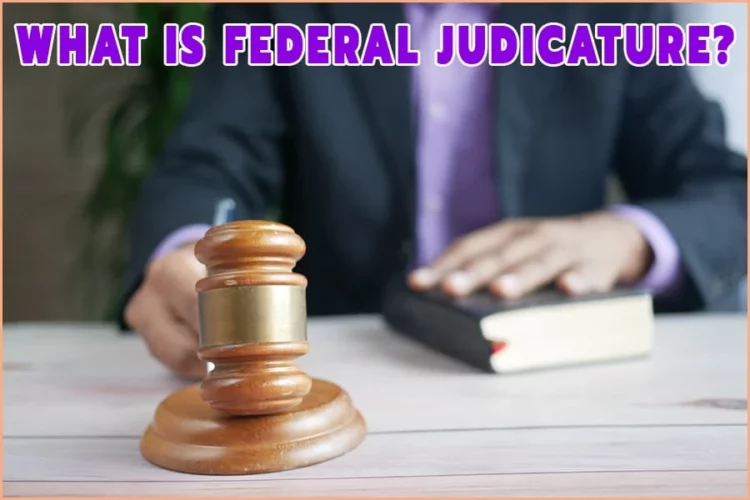The federal judiciary functions separately from the other two arms of government (legislatures and executives) but work with them as the constitution permits.
The federal judiciary refers to a branch of government that includes the Supreme Court, Court of Appeal, and Federal judges, together with the laws they interpret and enforce.
The federal judiciary has specific roles backed by the United States Constitution. But before we consider what those roles are, let’s define the term below.
What Is Federal Judicature?
Federal judicature refers to the judiciary of the federal government.
Judicature also means judiciary. It refers to the legal system, including the work it does.
Article III of the U.S. Constitution established the federal judiciary. And these include the Supreme Court and the lower federal courts created by Congress.
Additionally, keep in mind that state and federal judicial powers differ. While the state judiciary can exercise general jurisdiction, federal judicial power ends in cases under the constitution and the United States laws.
Keep reading to get more information on this topic!
The Structure Of The Federal Court System In The United States
The constitution established the judiciary and other branches of government. It also gives Congress the responsibility to structure the country’s federal court system.
Congress established the United States lower federal courts via the Judiciary Act of 1789. It was officially titled “An act to establish the United States judicial courts.” George Washington was the president that signed it into law on September 24, 1789.
So, how was the Supreme Court established? The Supreme Court, the highest court in the land, wasn’t established by Congress. It was established by Article III of the U.S Constitution. The constitution only granted Congress the power to establish lower federal courts.
What are lower federal courts? Two types of lower federal courts exist. These include District Courts and the Appellate Court (Court of Appeal).
The District Courts are the federal judiciary trial courts. The Appeal Court hears appeals on cases decided at the District Court.
How Are Judges In Lower Courts Appointed?
Judges in Supreme and lower courts (District and Appellate Courts) get lifetime appointments. The lifetime appointment means they can remain in office for life. Only retirement, death, or conviction can remove a judge from office.
Federal judges’ lifetime appointment limits political influence on the judiciary system. It enables judges to deliver judgments without pressure from politicians or the public.
Unlike other political office holders, federal court judges are not elected by electorates. It’s the president’s responsibility to nominate judges for lower court positions. But Congress has the power to confirm candidates they find suitable for the position.
A Handy Tip: The constitution empowers Congress to determine the number of Supreme Court justices.
Powers The Federal Judiciary Possesses
All branches of government have powers backed by the constitution. The federal judiciary has specific powers, as stated in the constitution.
Now, what powers does the federal judiciary even have?
Congress passes federal laws, which the president has to sign. But the federal judiciary determines a federal law’s constitutionality and resolves disputes regarding federal laws.
The court decides what happened, including what could be done about a case. It determines whether an individual truly committed a crime and what the punishment should be if found guilty.
Now, let’s discuss the roles of the different federal courts
The Supreme Court:
The United States of America has only one Supreme Court. And the Supreme Court is the final arbiter of the law. Its role is to assure American citizens that equal justice under the law will continue to take center stage.
The Supreme Court also serves as guardian and interpreter of our constitution. It boasts the power of judicial review, which implies the authority to declare unconstitutional, certain acts of Congress and state legislatures.
A Handy Tip: The Supreme Court receives over 7000 review requests yearly but only hears 100 to 150 of those cases.
The Court of Appeal:
The appeal court, also called the appellate court, sits below the Supreme Court. And there are 13 appellate courts.
So, what duty does the court of appeal perform? Firstly, let’s explain the structure of the District courts, including how they come under the appellate court.
There are 94 district courts in the United States, structured into 12 regional circuits. And each of the regional circuits has an appeal court.
In other words, there is an appeal court for each circuit, and remember, the appellate court has to check whether the trial court (District courts) applied the law correctly or not.
A Handy Tip: Each appellate court has three judges. Additionally, the appellate court doesn’t use a jury.
District Courts:
As earlier explained, the United States of America has 94 District Courts, also called trial courts. And each state, including the District of Columbia, has at least one District Court.
So, what role does the U.S. District Court perform? District courts resolve disputes. They determine the facts and apply legal principles in cases to decide who is right and who is wrong.
Unlike appellate courts, trial courts use a jury. The district judge tries the case while the jury decides it.
A Handy Tip: Magistrate judges are different from district judges. They help district judges prepare cases for trials but can also try misdemeanor cases.
Unlike district judges that get nominated by the president and confirmed by the Senate, magistrate judges are appointed via majority votes. Those eligible to vote are federal district judges from a specific district.
Additionally, district judges serve lifetime appointments, while magistrate judges don’t. A magistrate judge can serve for eight years when working full-time or four years if working part-time.
The district may also decide to reappoint a magistrate judge at the end of the judge’s tenure.
Conclusion
What is federal judicature? We have explained what federal judicature is in plain terms. It refers to the federal judiciary system.
The U.S. Constitution formed the Supreme Court, the highest court in the country. The same constitution also empowers Congress to decide the structure of the lower courts.
The lower courts include the District Courts and the Appellate Courts. And while there are 94 District Courts across the country, only 13 Appellate Courts exist.










